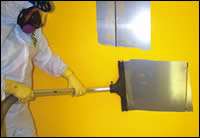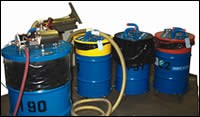A Phoenix without Ashes...
Safety-conscious Phoenix Wire Cloth (Troy, MI) wanted to purchase a grounded vacuum cleaning system in an effort to eliminate the dangers of powder combustion. In doing so, the company has also maximized powder recovery and minimized cleanup time.
#vacuum-vapor
Although the powder coating process offers important advantages—beautiful cosmetic appearance, durability, overall quality and economies—that make it the finish of choice among many manufacturers of industrial and consumer products, the process also introduces health and safety issues that make cleanup of powder coating booths more important than mere housekeeping.
Worker exposure to inhalable particles, the possibilities of powder combustion and environmental damage are all potential hazards that must be dealt with by manufacturers who use powder coating technology. While the basic requirements to minimize these hazards are spelled out by OSHA and other agencies, it is also clear that the avoidance of some risks can be determined by the choice of an ancillary tool that is needed in the powder-coating booth—the vacuum cleaner.
Featured Content
Some powder coating operations inadvertently use the familiar “shop-type” vacuums to clean their powder coating booths. This is especially common among manufacturers who are new to powder coating technology. While the “shop-type” vacuums may be appropriate for some light-duty cleanups, they are generally unsafe for use in a powder spray booth. Furthermore, the use of an inappropriate vacuum cleaning system may cause the powder spray operation itself to lose economies from the recovery and reuse of overspray powder, incurring the added expense of having to dispose of wasted powder.
“Combustion of powder coatings can occur when airborne powder comes in contact with a source of ignition, such as static electricity generated by ungrounded vacuum cleaners,” warns Steve LeFever, an engineer with Phoenix Wire Cloth, Inc., Troy, MI. “Powder flowing in one direction through a plastic vacuum-cleaning hose can create a significant static electric charge. Plus, there is the possibility that there may be a static electricity build-up on the powder coating deposits. If a charged ungrounded hose used to vacuum overspray powder were to contact an object that was grounded, the static electricity could then arc and trigger a violent explosion.”
Powder combustion has resulted in raging fires that have caused catastrophic damage to factory facilities and have resulted in costly shutdowns, such as in grain elevators.
Mr. LeFever says Phoenix Wire Cloth, which has manufactured wire mesh and related products for over a century, wanted to purchase an industrial-grade vacuum cleaning system to provide the needed safety plus other important benefits to its powder coating operation.
Phoenix Wire Cloth converted its metal finishing process to powder coating about five years ago. The company, which manufactures a wide range of wire mesh-based products, such as wire baskets, partitions, guards, cloth and security fencing, also uses a variety of metals to fabricate screen, including stainless steel, bronze, aluminum, copper, tinned steel and high-temperature alloys. The powder coat finishing process is applied to its safety systems, including robotic enclosures, wire mesh partitions, stair rail inserts, machinery guards and focal displays.
“We were a perfect candidate for powder coating technology and a perfect candidate for a vacuum-based cleaning and recovery system,” says Mr. LeFever, who headed up the selection of a new vacuum system last fall. The potential Mr. LeFever saw was for faster turnaround on setups for new paint colors plus a certain amount of savings by recovering powder overspray, as well as an improved safety factor.
Phoenix Wire Cloth normally uses three basic colors in its powder coat operation, although special colors and clear-coat are also available. Each time a color change is required, the powder spray booth has to be cleaned and overspray must be vacuumed out of the spray booth. Some products, such as safety fences, receive two or three different colors, but otherwise, powder colors are changed at intervals subject to sales orders.
“The safety fences that we manufacture are powder coated in a rather small booth, approximately 5 x 20 ft,” Mr. LeFever explains. “And we have no space available for an additional powder coating line and baking facilities. So, by speeding up the cleanup process, we are speeding up overall productivity for powder coated products.” One of the ways cleanup time could be improved was to make sure that a squeegee was integrated into the vacuum system. There was also a likely substantial savings in labor over the old method, which included a “shop-type” vacuum, squeegeeing, air blow-off and wipe down of the spray booth by hand.
Because color changes occur on an as-needed basis, it is hard to say how much money the company was likely to save through recovery and reuse of powder overspray. Mr. LeFever was aware that recovery was often a significant factor in powder coating operations, so he decided that the new vacuum system should have separate recovery canisters for different powder colors. Not only would that enable reuse of the powder, but would obviate the need to treat the powder as hazardous waste—another savings.
Once the vacuum cleaning system specifications were decided, Phoenix Wire Cloth evaluated several different suppliers and technologies. Ultimately, the company elected to work with VAC-U-MAX (Belleville, NJ), a supplier of vacuum cleaning equipment and conveyors.
The system that Phoenix selected was the VAC-U-MAX MDL 55 model, a portable 55-gallon unit with changeable collection containers. The unit is completely grounded, so there is no danger of an explosion or fire resulting from static discharges during vacuum clean-up operations. It also includes a wand and squeegee, so users can clean the walls and floor of the spray booth quickly. Phoenix also purchased three collection canisters, allowing them to recover their three basic colors in separate containers for later reuse. “Basically, the cleanup operation is now just a matter of blowing out the hoses, squeegeeing the booth and vacuuming the powder,” said Mr. LeFever.
Saving Money and Ensuring Safety
Mr. LeFever says that the most meaningful savings with the new cleaning system is on labor, although productivity improvements and powder recovery should also prove to be substantial. “With the material savings, the savings will mount up, but it’s actually relative to the number of times we change color in the spray booth. We may be running a color for four days before we have to make a change, then need to change color again within a day. So, material savings will be a function of how often we have to clean the spray booth."
The vacuum technology selected by Phoenix features VAC-U-MAX’s Venturi compressed air-powered vacuums with anti-sparking vacuum inlets and grounding lugs, which significantly reduce the risk of combustion. Optional stainless steel anti-sparking construction of the cover, suction inlet, and all internal contact parts, excluding the filter, minimize the possibility of sparking resulting from dynamic contact between the suction inlet and particles drawn into it. Static conductivity from end to end, including a static conductive hose with internal ground wire and grounded end cuffs, further prevents static build up. “As for the risk of static electric discharge, we are confident that it has been minimized,” Mr. LeFever says.
Together these measures safeguard the cleanup of excess powder from fires or explosions related to static discharge or accidental electrical ignition. Optional static-conductive filters, rated 99.9% efficient at one micron, further reduce sparking danger, while virtually eliminating any fine particle discharge from the vacuum’s exhaust back into the work area. This ultra-fine filtration helps to create healthful, productive breathing conditions in the workplace.
ABOUT PHOENIX WIRE CLOTH, INC
Founded in Detroit, MI in 1885, Phoenix Wire Cloth, Inc., manufactures and imports industrial wire cloth, welded mesh and alloy baskets. Services employed by Phoenix include slitting, cut pieces and special short run odd alloy weaving. The company also manufactures safety systems, including robotic enclosures, wire mesh partitions, stair rail inserts, machinery guards and focal displays. Phoenix employs approximately 60 people in a 60,000-sq ft facility in Troy, Ml and ships its products around the world.
Phoenix Wire Cloth, Inc.
585 Stephenson Hwy., Troy, Ml 48083-1134
Phone (248) 585-6350/(800) 458-3286
Fax (248) 585-4121 / (248) 585-9029
or visit the web site:
http://www.phoenixwirecloth.com
RELATED CONTENT
-
A Lustrous Example of Expanding a Plating Operation
Ohio’s Lustrous Metal Coatings Pins Growth on Acquiring Other Manufacturing Operations
-
Mechanical Vapor Recompression Evaporation
MVRE is underutilized in the treatment of industrial wastewaters that are typical of metal fabricating and finishing industries. Increasing energy costs, rapidly decreasing freshwater resources, and growing sensitivity towards the environmental impact of industrial management practices are the driving forces in the development of more sustainable technology.
-
Are Ionic Liquids Right for Your Parts Cleaning Job?
Ionic liquids have also been considered for parts cleaning applications because of their negligible vapor pressure, high thermal and electrochemical stability, and low melting points of less than 100°C.




















